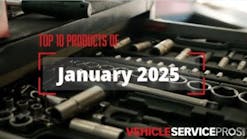Trends affecting the automotive aftermarket are challenging, but Mark Seng, vice president and global aftermarket practice leader for Polk, the automotive research firm, also gave reason for optimism during his presentation at the Town Hall meeting for the Automotive Aftermarket Products Expo at the Sands Expo Center. Seng’s presentation was titled, “Five Trends in Five Minutes.”
Trend One: One of the most positive indicators he noted is that light vehicle registrations increased by 8.5 percent in 2013, marking recovery since the 2008 recession. He predicted that by 2014, the industry will be back to its pre-recession levels with 16 million new cars sold. He noted that the major automakers are doing well.
Fueling the growth is an increase in new model designs, Seng said.
Trend Two: Average vehicle age continues to climb. “Average vehicle age has been on the rise ever since we’ve been tracking it,” he said. The average vehicle is now 11.3 years old and by 2015, Seng expects it to reach 11.4 years. This is good news for the aftermarket because older vehicles require more maintenance and repair.
The growth in the average vehicle age will slow after 2015, Seng said, then resume in 2018 when he expects it will reach 11.5 years. “Vehicles are lasting longer than ever before,” he said. He noted that cars six to 11 years old are more likely to be fixed by a professional aftermarket shop. Vehicles that are 12 years and older are more likely to be fixed by a do-it-yourselfer.
Trend Three: The shift in the vehicle mix – to smaller sizes – will impact the aftermarket. “All large vehicle segments are in decline except the large pickups,” he said. Consumers are driving smaller vehicles thanks to advances in 4-cylinder combustion engines, which provide sufficient power and fuel efficiency for consumers, Seng said.
Trend Four: OEM globalization is becoming the new norm. OEMs are accelerating the use of global platforms. OEMs are reducing the number of platforms so they can produce more cars per platform. This is allowing them to build cars more economically. “The number of vehicles per platform will grow substantially,” he said.
The standardization of production architecture will affect the types of vehicles the aftermarket will be fixing, he said.
Trend Five: Technology is advancing to meet CAFÉ (Corporate Average Fuel Economy) standards. OEMs continue to invest heavily in internal combustion engines even as diesel and electric hybrid cars increase, he said.
OEMs have made more efficient transmissions with more speeds in cars powered by internal combustion engines, Seng said.
One challenge confronting the aftermarket is that recommended intervals for oil changes are increasing, Seng noted. New powertrain technology and synthetic oils have increased the length of time between suggested oil changes. This presents a challenge to the aftermarket industry because the oil change is the most frequent opportunity for aftermarket shops to suggest repairs.
Seng also noted that telematics presents a serious challenge to the aftermarket since OEMs will use telematics to advise car owners to visit OEM dealers for service. He said the aftermarket should be able to find ways to meet this challenge.
Seng applauded the Automotive Aftermarket Industry Association for launching its Aftermarket Telematics Challenge which recognizes the best example of connected-vehicle technology that can be fitted to vehicles in the aftermarket. This year’s Aftermarket Telematics Challenge winner is Verizon.


